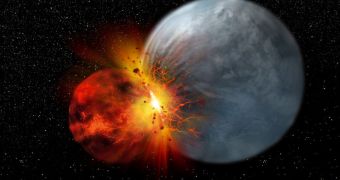A group of investigators at the University of Zürich, in Switzerland, working together with colleagues at the NASA Jet Propulsion Laboratory (JPL), in Pasadena, California, recently determined that as many as 1 in 12 terrestrial extrasolar planets may harbor a Moon-like natural satellite.
UZ experts Sebastian Elser, professor Ben Moore and Dr. Joachim Stadel and JPL research scientist Ryuji Morishima conducted a series of computer simulations meant to provide an accurate estimate of just how many worlds may benefit from the stabilizing effects of a large moon.
As far as our own planet is concerned, the influence the Moon had cannot be stressed enough, planetary scientists and astronomers alike argue. The natural satellite formed during the earliest days of the solar system, after a Mars-sized body collided with our planet.
This event broke huge chunk of mass off Earth, which then coalesced into the Moon. Originally, it was located a lot closer to our planet than it is today. Over the years, it provided numerous benefits for Earth, including keeping its axis stable, tilted at a 23-degree angle.
Many evolutionary biologists believe that it was this steady influence that allowed early life to thrive here, eventually “growing up” and evolving into more complex lifeforms. Without the Moon, our planet would have gone through massive climate variations, impeding the development of life.
This is why astronomers are so curious to learn how many planetary systems out there might emulate this setup. Few Earth-like exoplanets have ever been discovered, but the new computer models indicate that 1 in 12 may have Moon-sized satellites orbiting them at a similar distance.
In the models, the investigators simulated the interactions taking place in the protoplanetary disk around a newborn star. All planets, asteroids and comets in our own solar system were formed from such a disk, when the Sun was only millions of years old.
Throughout the numerous instances they ran the models, the joint team identified satellite-forming collisions that resembled what astronomers know about the collision between early Earth and the Mars-sized impactor, SpaceRef reports.
The simulations revealed odds between 1-in-4 and 1-in-45, so researchers selected the middle-ground, saying that more, similar models need to be ran before they can provide an exact answer. However, the fact that the percent is non-zero provides another ray of hope for finding an Earth-analog.

 14 DAY TRIAL //
14 DAY TRIAL //